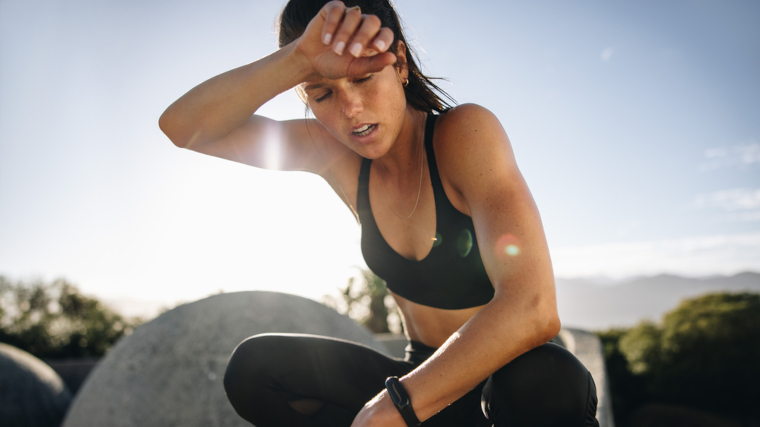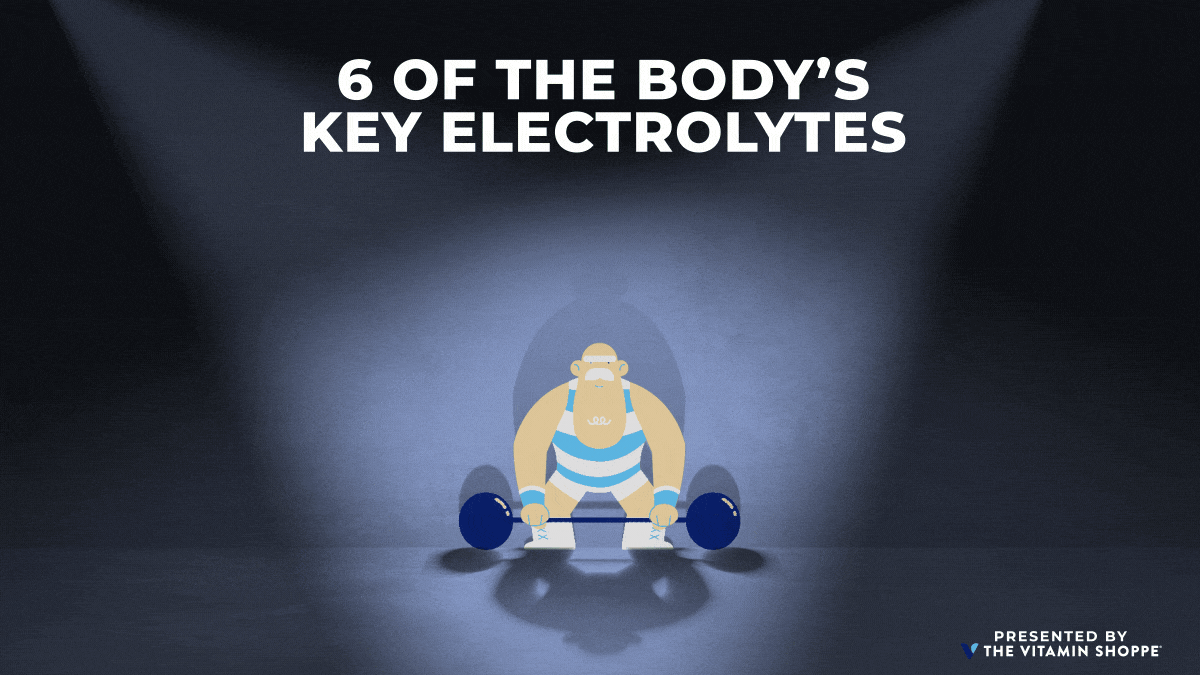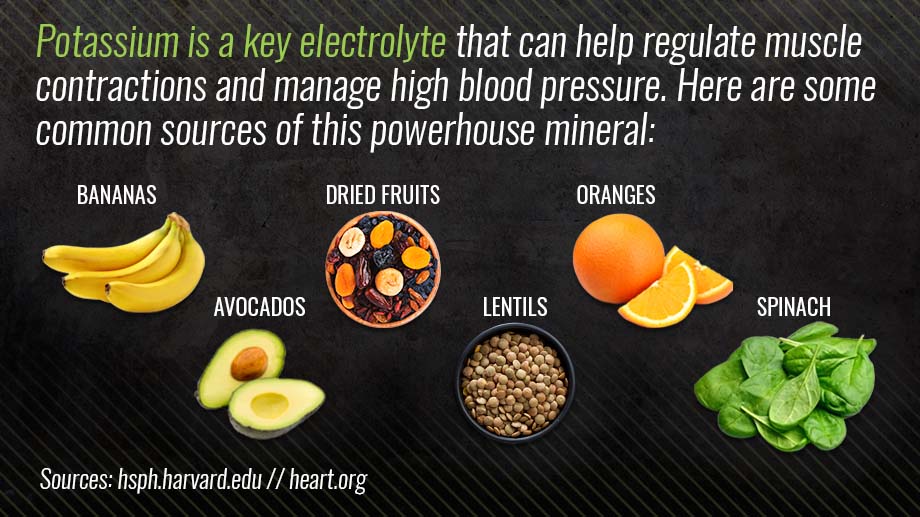If all of your education about electrolytes has come from commercials on television or ads on social media, you’ve probably grown convinced of the fact that you’re probably not getting enough of them… whatever they are.
It can be difficult to convince someone of their need for a nutrient if you can’t plainly articulate what that nutrient is, where it comes from, or what it accomplishes that’s of any tangible value. Well, in the case of electrolytes, you should definitely pay close attention, because a lack of these nutrients can seriously hamper your ability to reach your fitness goals.
To shine some light on the topic, BarBend has teamed up with The Vitamin Shoppe — home to a range of hydration and electrolyte supplements from Liquid I.V., Kaged, and more — to detail six signs that you’re not getting enough electrolytes, along with easy ways to replenish these essential minerals.
Editor’s Note: The content on BarBend is meant to be informative in nature, but it should not be taken as medical advice. When starting a new training regimen and/or diet, it is always a good idea to consult with a trusted medical professional. We are not a medical resource. The opinions and articles on this site are not intended for use as diagnosis, prevention, and/or treatment of health problems. They are not substitutes for consulting a qualified medical professional.

Prepare for your next training session with the help of The Vitamin Shoppe's selection of hydration and electrolyte products from brands like Liquid I.V., Kaged, Nuun, and more!
What Are Electrolytes?
Far from being a single nutrient that can be neatly described, electrolytes are actually a collection of minerals — including sodium, potassium, chloride, calcium, magnesium, and phosphate — that are frequently found in food and beverages. Each of these minerals contributes to the efficiency of myriad essential functions in your body. However, when they are collectively grouped and labeled as “electrolytes,” these minerals are usually referenced with respect to their ionic properties, particularly their ability to maintain and optimize hydration levels within your body.
Electrolytes carry positive and negative electrical charges, and when they pass through cell walls, they enable water to follow along with them. In the process, they escort that water to the parts of your body that require it the most. Aside from hydration maintenance, the different electrolytes all have additional responsibilities. In their specialized roles, their functions include helping your body convert nutrients into energy, assisting with the maintenance of heart functionality, and even normalizing your body’s pH level.
6 Signs You’re Not Getting Enough Electrolytes
Although electrolytes are commonly marketed as if they’re an optional nutritional supplement, the fact of the matter is that your body simply can’t survive without them.
Thankfully, it’s relatively easy to load up on these nutrients, and your body will give you some obvious warning signs that you are running low on electrolytes before anything catastrophic occurs. Here are six symptoms to look out for:
Dehydration
In and of itself, dehydration may simply be a sign that you haven’t consumed enough fluids over the course of a day. However, if one of the contributing factors toward your hydration is a long-lasting, clothes-drenching workout, your body could be low on electrolytes.
Without electrolytes in your system to act as a conveyance mechanism for fluids, water will have a challenging time being transferred into the cells that need it most, and that includes any inbound water you consume after your workout is already in progress.
Weakness
Magnesium and phosphate both play essential roles in enabling your body to make use of the nutrients in your food. Specifically, magnesium helps your cells to transform food into energy, and phosphate helps your cells to metabolize food and extract all of its micronutrient value. In the absence of these two electrolytes, your body faces an uphill climb as it attempts to reap the full benefits of your meals, resulting in muscle weakness.
Muscle Twitching
If your muscles seem to be twitching and spasming out of control, it may be owed to a shortage of calcium and chloride. Because chloride is involved in smooth muscle contraction, its absence during the process of chloride-bicarbonate exchange can lead to involuntary muscle spasms. Similarly, calcium plays a role in muscle control and the transmission of signals that control muscles. Without these two electrolytes keeping a tight rein on your muscles’ control mechanisms, twitching may ensue.
Vomiting
Sodium and chloride play respective roles in the regulation of fluid throughout your body, along with controlling its pH level. These are two critical functions for sustaining your body’s chemical balance, and if your body is disrupted due to a lack of either nutrient, vomiting can result, as a rather alarming sign that something is amiss. Fortunately, a shortage of these nutrients is exceedingly rare, as their absence can be overcome with a few dashes of table salt.
Cramping
If you ever suffered from cramps during any form of organized sports practice, your coach probably admonished you to eat a banana. The reason for this is simple: Cramping can be one of the most visible and obvious signs of a shortage of potassium in your diet. Potassium provides much of the communication between muscles and nerves, and plays a crucial role in muscle contractions. When potassium levels are low, muscles can get caught in a contracted position, which is what your body interprets as a cramp.
Irritability
It’s true that any of the aforementioned conditions might be more than enough to boost your irritability, or at least to lower your patience level toward any further catastrophes. However, if you’ve been making a concerted effort to avoid adding salt to the food on your plate, it’s quite possible that your irritability is the chemical byproduct of a diet low in sodium. Though rare, it does occur in the elderly and could happen to anyone after excessive sweating. In addition to irritability, mental fog and headaches are other symptoms.
What Causes Electrolyte Loss?
The foremost cause of electrolyte loss — especially the sort of electrolyte loss that might leave you suffering from the aforementioned symptoms — is sweating as a result of physical exertion. If you have a balanced diet or nutrition plan, such instances of debilitating electrolyte loss are rare if you exercise for less than an hour at a time. However, if your training sessions stretch to durations that exceed one hour in length, you may want to reach for an electrolyte-rich source to restore your lost minerals.

Other causes of electrolyte loss include various diseases, like cancer, kidney disease, cirrhosis, or cardiovascular disease. It may also result from health problems that are often episodic, like vomiting or burns. On the other hand, electrolyte loss has also been tied to the use of certain medications, like antibiotics, corticosteroids, diuretics, laxatives, and chemotherapy drugs. Similarly, substance abuse has also been linked with a subsequent absence of electrolytes.
How to Get More Electrolytes
Given the necessity of electrolytes, combined with the general disregard that people often have toward consuming them, you might assume that people’s bodies would be breaking down from electrolyte depletion on a frequent basis. Fortunately, electrolytes are so plentiful that it is quite possible to consume them in sufficient quantities without paying close attention to what you’re doing … not that it wouldn’t help you to know where to look.
Sodium and Chloride
The most common source of both sodium and chloride is table salt, which is 40 percent sodium and 60 percent chloride. Most processed foods, including pickled vegetables and ordinary cheeses, are high in sodium, which is used as both a flavoring and a preservative. Even foods like eggs, milk, sweet potatoes, and celery are relatively high in sodium without having anything additional sprinkled upon them.
Chloride is similarly found in large quantities in processed foods like potato chips, deli meats, cheese, and butter, and also in condiments like soy sauce and ketchup. Among the foods naturally abundant in chloride are shrimp, seaweed, potatoes, and bananas, but even carrots contain respectable amounts of chloride.
Calcium
Anyone who has ever paid attention to any dairy industry commercials is aware of the fact that milk and all of its derivative products — including cheese, yogurt, and whey protein — are loaded with calcium. However, if you prefer to procure your electrolytes from non-animal sources, sweet potatoes, oranges, broccoli, and almonds (including almond milk) will all flood your system with plenty of calcium.
Potassium
Potatoes and bananas are two of the popularly referenced sources of potassium, but it is also prevalent in other vegetables like spinach, broccoli, and tomatoes. If you skew toward the carnivorous side and would prefer to consume your electrolytes through animal products, potassium is also present in chicken and fish.
Magnesium
When it comes to magnesium, your best bet is to think in terms of nuts, grains, and seeds. It’s true that magnesium is available in milk, spinach, and avocados, but its most notable sources are brown rice, bread, oats, almonds, peanuts, pumpkin seeds, and cashews.
Phosphate
Phosphate is the naturally occurring form of phosphorus, so it might be listed under either name, depending on a product’s packaging. It is abundant in several meat sources, including chicken, pork, beef, and tuna. As an alternative, plant-based phosphate sources include nuts, beans, sesame seeds, pumpkin seeds, quinoa, and mushrooms.
Beyond ingesting electrolytes from relatively ordinary sources of food, it is common to find electrolytes — especially calcium and magnesium — in multivitamin supplements. Of course, there are also several specialized hydration supplements that frequently contain a mixture of sodium, calcium, potassium, and phosphate. Several varieties of multivitamins and hydration products can be readily purchased at specialty nutrition stores like The Vitamin Shoppe.
What Is the Daily Amount of Electrolytes You Need?
According to the Dietary Reference Intake guidebook of the Institute of Medicine, the recommended daily intake of each of the core electrolytes for most people is as follows:
- Sodium — 1,500 mg
- Chloride — 2,300 mg
- Potassium — 4,700 mg
- Magnesium — 420 mg for men / 320 mg for women
- Calcium — 1,000 mg
- Phosphate — 700 mg
If these numbers look daunting, don’t fret. The sodium and chloride requirements can be consumed in a single teaspoon of salt. An adequate dose of magnesium can be acquired through a single plate of tuna, spinach, brown rice, and lima beans. You can fulfill the calcium requirement with two glasses of milk and some yogurt.
The potassium threshold can be reached with a plate of salmon, some potatoes, and cooked tomatoes, with a banana and an avocado thrown in throughout the day. As for phosphate, you can meet that goal by eating your choice of meats, including beef, fish, pork, or chicken.
Boost Your Electrolytes
As you can plainly see, there is more to electrolytes than you may have initially suspected. Also, just because you’re getting sufficient quantities of one electrolyte in your diet, or theoretically meeting your daily requirement for total electrolytes, that doesn’t mean you’re matching your requirement for each of them individually.

Prepare for your next training session with the help of The Vitamin Shoppe's selection of hydration and electrolyte products from brands like Liquid I.V., Kaged, Nuun, and more!
Other than through food sources, one of the ways you can ensure you’re meeting your electrolyte goals is through supplementation. And right now, The Vitamin Shoppe has a range of electrolyte and hydration products available from brands like Liquid I.V., Kaged, Nuun, BodyTech, and more. Head here to see what’s on offer and peruse all the latest deals.
Featured Image: Prostock-studio / Shutterstock

